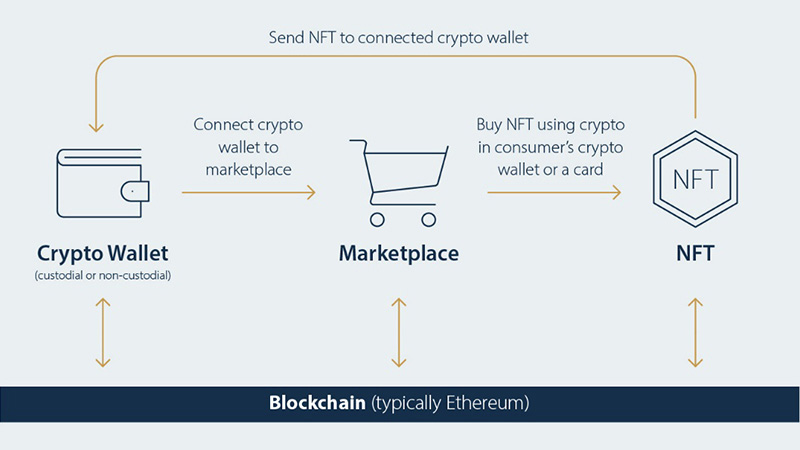

With more than $1B of value traded in August alone,¹ non-fungible tokens (NFTs) are gaining momentum through collections of digital-first memorabilia. While the prices of individual NFTs fluctuate, fascinating use cases for NFTs are still emerging and the groundwork is being laid for the long-term utility of NFTs. This new form factor for commerce has vast potential, representing a deeper and more dynamic way to engage customers and potential new revenue streams for organizations.
For the first time, content on the internet in the form of an NFT can be definitively owned by a specific person independent of a centralized intermediary, and this is unlocking exciting opportunities for digital commerce and engagement.
Unlocking New Commerce and Engagement Opportunities
NFTs appeal to merchants, collectors, customers, and talent, particularly in industries like music, gaming, art and sports. They have become a great way for individuals and businesses to capitalize on unique assets, engage customers and potentially generate revenue, while staying ahead of the curve and keeping pace with innovations in commerce.
“NFTs have the potential to become a powerful accelerator for the creator economy and lower the barrier to entry for individual creatives to earn a living through digital commerce. NFTs are starting to usher in a new form of social commerce that empowers both creators and collectors,” says Cuy Sheffield, Head of Crypto, Visa.
Because the opportunities for growth with NFTs are still evolving, businesses should define what their end goals are around NFTs. Some of the common ways brands are using NFTs to grow their business include:
- Customer engagement – NFTs can be much more than a collectible or piece of art, and savvy brands are recognizing that the most successful and long-term-relevant NFTs will be ones that have ongoing value and utility. For example, NFTs can better connect fans to their favorite teams or brands by offering voting rights to team decisions, access to exclusive offers, and the ability to earn rewards.
- Customer relationship management – Unlike physical goods, NFTs are trackable so it can be possible to see what wallet address they reside in. NFTs can open unique segmentation and engagement strategies based on trackable factors related to the NFTs owned/purchased. This might include the types of NFTs owned, the quantity owned, or the duration they’ve been held.
- New potential revenue streams — Because NFTs enable digital scarcity, brands can sell exclusive, limited digital goods. Unlike physical goods, NFTs can include a smart contract that codes in a royalty percentage designated by the content creator. As such, subsequent sales or auctions of the NFT can generate revenue for the original NFT creator, providing an ongoing potential revenue stream as it is sold or auctioned.
How to Integrate NFTs
There are seven steps to consider for integrating NFTs successfully into a business. Many of the solutions today are vertically integrated; in the future, the expectation is that there will be more flexible enterprise solutions.
1. Identify the NFT use case
First and foremost, there should be alignment on how NFTs will be used. Depending on the use case, there are different mechanisms to design an NFT, like edition, size and distribution. Some of the most prominent use cases seen to date include collectibles, art, gaming, and experiences.
2. Determine the appropriate blockchain
Selecting the appropriate blockchain requires evaluating tradeoffs across multiple dimensions including throughput, transaction cost, existing ecosystem of applications, and degree of decentralization. Additionally, while a business may start creating NFTs on one blockchain, there are likely to be many other blockchains that support NFTs in the future and they may want to create NFTs on multiple blockchains.
The ideal infrastructure partner would support multiple blockchains and enable interoperability of assets between blockchains.
3. Mint the NFTs
After determining what content to use, the NFT needs to be created, or minted. To mint an NFT, a cryptographic key is used to create a token on the blockchain that represents a piece of digital media. Important characteristics, like the name, description, and the edition size can be included within that token. Once an NFT is minted, it is immortalized on the blockchain. It is important to have a minting platform that gives flexibility and control over the features of the NFT.
There are several platforms that can help with minting of NFTs. It is important to note that the ecosystem for this is in its infancy and many more are coming into the space. In creating NFTs, companies are well-advised to find providers who will mint NFTs according to custom smart contracts so that companies have as much control as possible over the parameters of the NFT, including provenance, attributes of the NFT, and storage of the underlying media asset.
4. Decide how to store digital assets in a long-term sustainable way
NFTs are either minted to contain the digital content file itself or to contain a reference to the digital content. Accordingly, it is important to understand how the digital content being distributed by the NFT is being stored. Many of the existing platforms that creators can use to create NFTs will host the media files through either decentralized or centralized storage methods.
5. Store and access NFTs securely and easily
Similar to cryptocurrencies, NFTs are stored in a crypto wallet – the digital equivalent to an address. There are several crypto wallets available, including wallets from top exchanges that manage assets on the consumers behalf to wallets that give consumer’s direct control over their assets. To maximize the addressable market, it is important to be able to integrate with many of these wallets, so that NFTs can be delivered to a maximum number of digital addresses.
There are two primary models for wallets – ‘custodial’ or ‘non-custodial’. Consumers that interact with crypto often prefer the ‘non-custodial’ model, as it gives them full control over their assets. By contrast, including a custodial solution can help provide a broader audience easy access to a business’ platform. If using custodial solutions, it is important that the solution is from a trusted brand with strong security, as it will be responsible for safekeeping the NFTs on behalf of the consumer.
6. Distribute across an applicable marketplace
Another important consideration is how to distribute NFTs. Factors for evaluating NFT marketplaces include: flexibility and control over the branding of the user experience; whether the marketplace allows users to purchase NFTs with fiat currency (dollars) or requires users to use cryptocurrency for purchases (for mainstream appeal, it is important to accept card payments); and the general audience of the NFT marketplace.

7. Identify additional opportunities to engage customers
Today, selling art and collectibles is the primary use cases for NFTs. While these use cases can generate revenue, there are untapped strategic opportunities that may be realized. For example, one exciting aspect of NFTs is their composability. As the ecosystem develops, NFTs can be designed in a way that spans multiple use cases. This long-term utility enables deeper engagement and ultimately creates more valuable NFTs that generate additional revenue on secondary sales or auctions. This area is rich for potential and can span multiple phases of the customer experience:
- Loyalty and Gamification: NFTs can be used as a reward to incentivize certain behavior. Alternatively, an NFT can be earned by completing a task, such as making a purchase at a specific merchant.
- Utility Across Metaverses: There are opportunities to imbue NFTs with enhanced utility by building functionality that can be used across different applications within multiple metaverses.
- Ticketing: In addition to being collectibles, NFTs can be combined with event tickets to provide access to an event. These tickets can provide verifiable authenticity, provide royalties upon secondary sales or auctions, and even turn digital tickets into unique commemorative assets.
- Customer Governance and Decision-Making: NFTs can be used to enable customers to impact decisions and outcomes of a team or brand.
- Customer Data with Pseudo-Anonymity: A customer’s crypto wallet and the assets they own reflect that customer. This can help inform marketing strategies and how to engage with the consumer in an ongoing manner.
Considerations Associated with Change
Innovation, particularly in cutting-edge areas, is not something that can be achieved on autopilot. NFTs are no exception, with a range of strategic considerations:
- Risk Management
- Environmental Impact
- Fees (i.e., blockchain transaction fees, marketplace fees, infrastructure costs)
- Licensing and T&Cs
- Legal and Regulatory
Commerce is evolving, and innovations such as crypto and NFTs are likely to shape sports, entertainment, and other communities going forward. NFTs represent a deeper and more innovative way for customers to engage and potential new revenue streams for organizations. However, there are many considerations to take into account when integrating NFTs because it is a new space.
Read more about Visa’s perspective: NFTs Engaging Today’s Fans in Crypto and Commerce.
All brand names, logos and/or trademarks are the property of their respective owners, are used for identification purposes only, and do not necessarily imply product endorsement or affiliation with Visa.